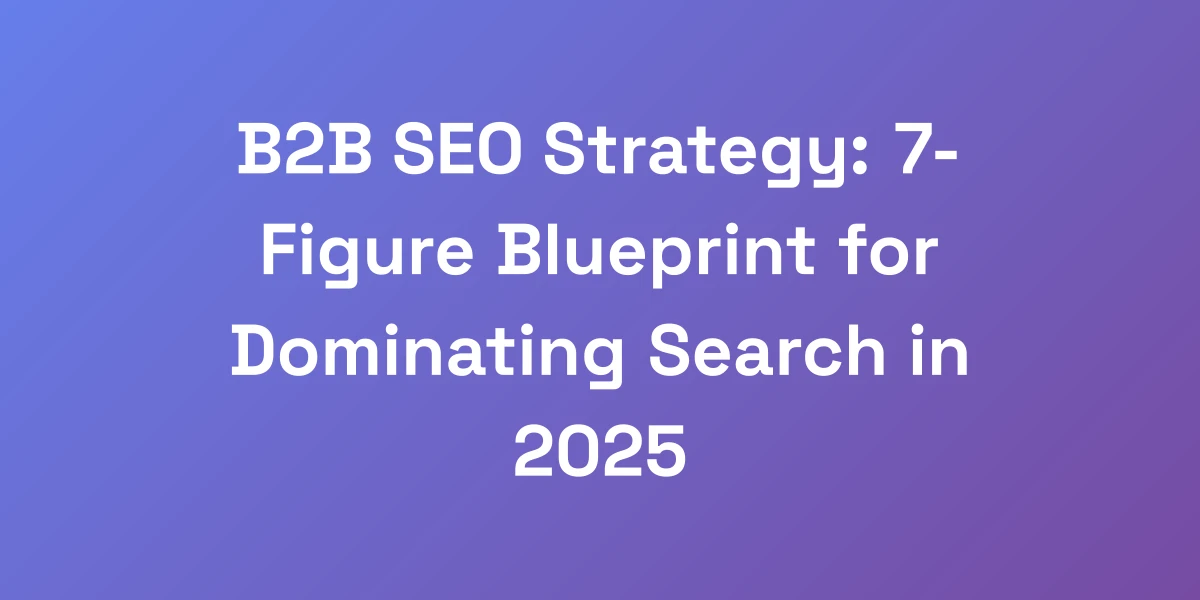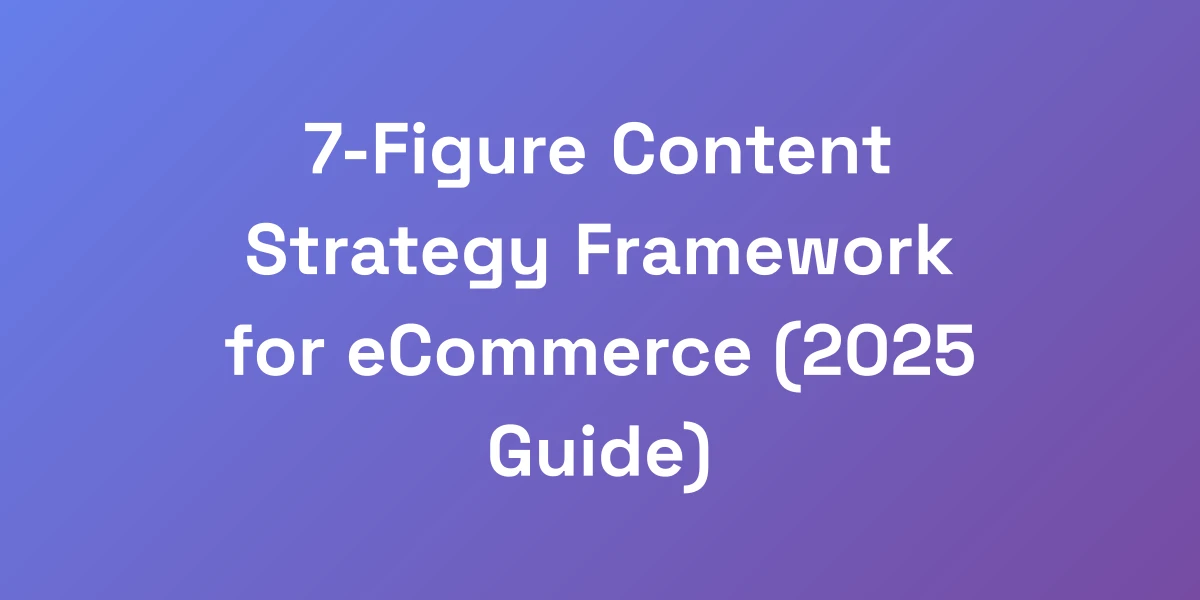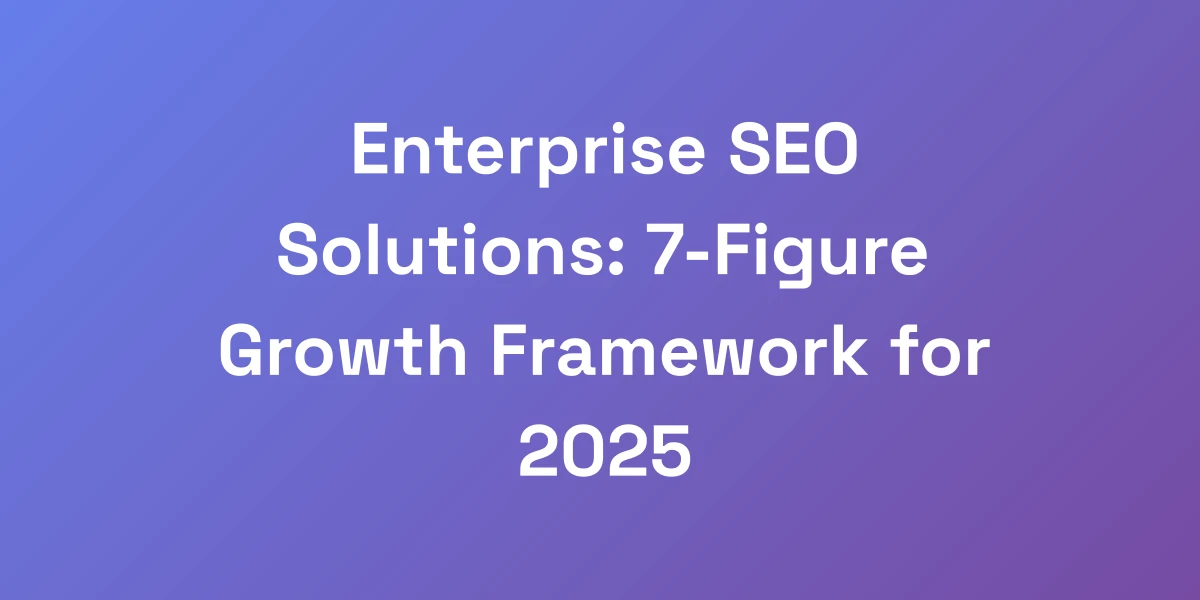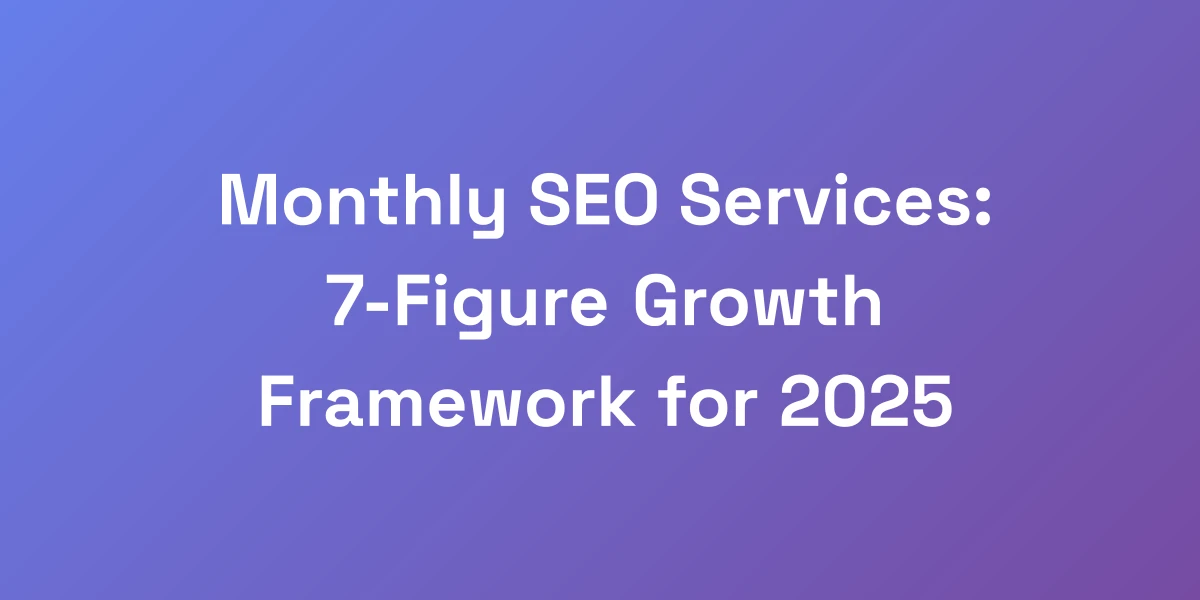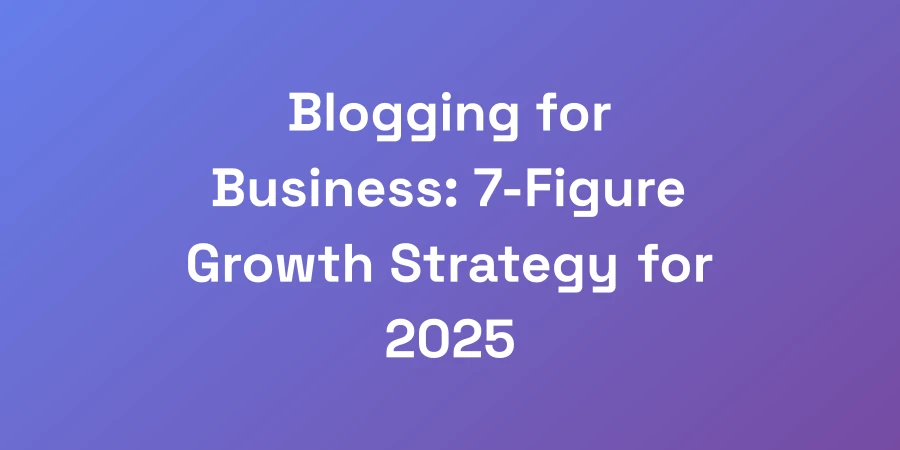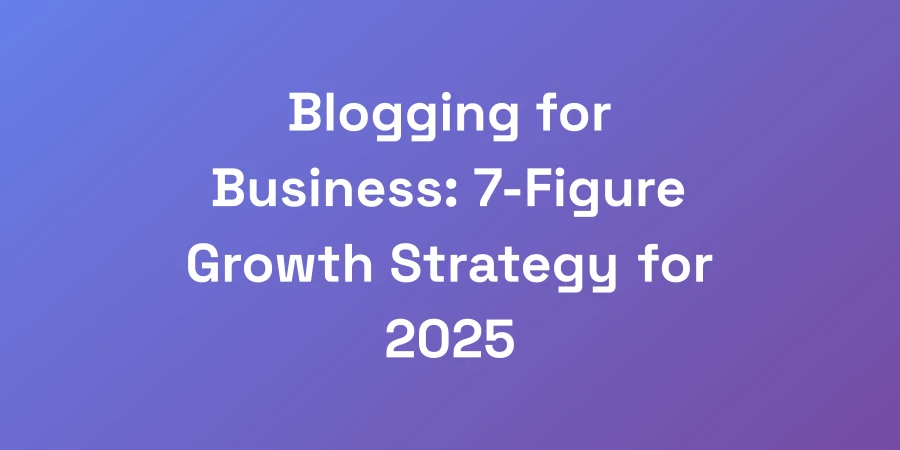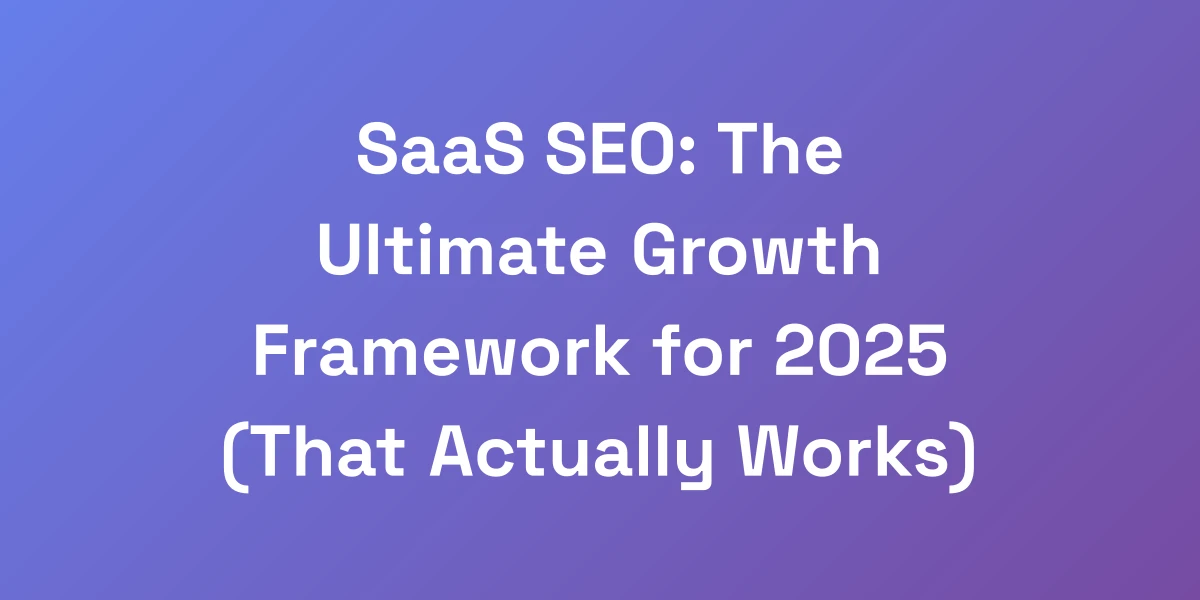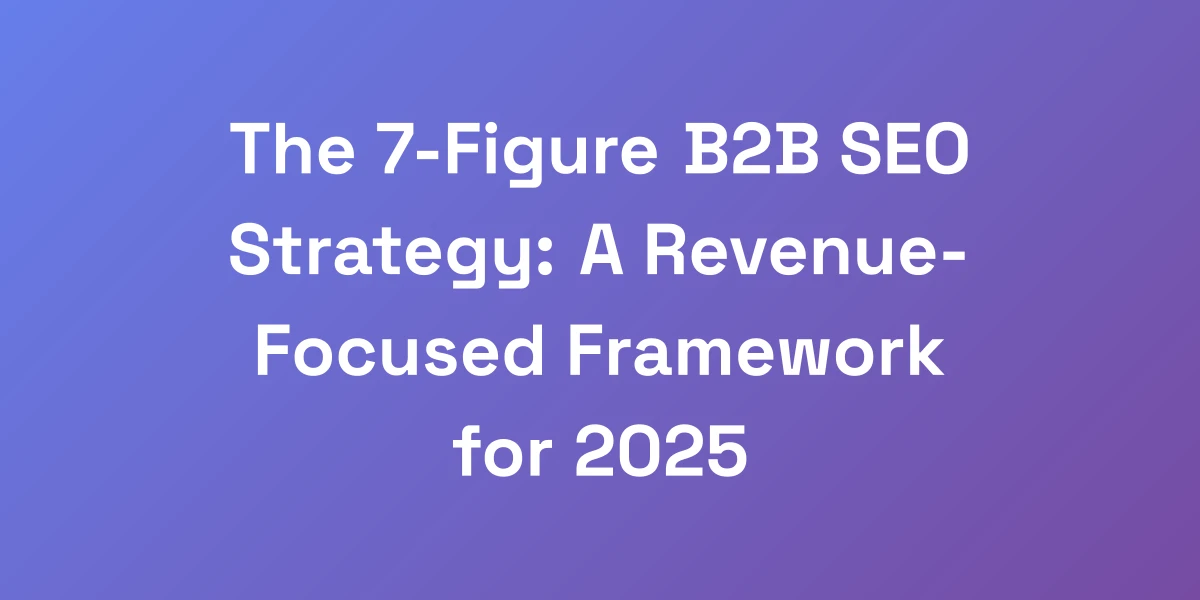
The 7-Figure B2B SEO Strategy: A Revenue-Focused Framework for 2025
Mar 27, 2025 | By [email protected]
Why Most B2B Companies Fail at SEO (And How to Win)
Let me be brutally honest: most B2B companies are lighting money on fire with their SEO efforts.
They’re obsessing over vanity metrics while their competitors are eating their lunch.
Here’s the truth – B2B SEO isn’t about traffic, it’s about revenue.
In my years of scaling businesses, I’ve noticed a clear pattern: companies that treat SEO as a lead generation machine, not a traffic game, are the ones that win.
Today, we’re going to show you exactly how to build a revenue-focused B2B SEO strategy that actually delivers results.
The Fatal Flaws in Traditional B2B SEO Approaches
Most B2B companies fall into the trap of focusing solely on increasing website traffic.
They push out generic content, hoping something will stick.
But without targeting the right keywords and understanding the buyer’s journey, their efforts crumble.
Have you ever wondered why despite all the traffic, conversions remain stagnant?
It’s because they’re missing the mark on what truly drives revenue.
The Revenue-First Mindset Shift
Shifting to a revenue-first mindset transforms your SEO strategy from a numbers game to a profit-driven engine.
Focus on keywords that align with your sales goals and target high-intent search phrases.
Ask yourself: “Is this keyword likely to convert into a paying customer?”
This approach ensures every piece of content you create is a step towards generating revenue.
Imagine your SEO efforts directly contributing to your bottom line – that’s the power of a revenue-first mindset.
Why Your Current Strategy Isn’t Working
If your current SEO strategy isn’t bringing in the leads you need, it’s time to reassess.
Are you targeting the right keywords? Are you addressing the true pain points of your customers?
Many companies waste time on broad terms that attract low-quality traffic.
Instead, zero in on niche keywords that your ideal clients are searching for.
It’s not about more traffic; it’s about the *right* traffic that converts.
The Real Metrics That Matter in B2B SEO
Forget vanity metrics like page views and general traffic numbers.
The metrics that truly matter are those that tie directly to revenue.
- Conversion Rate: How many visitors are turning into leads or customers?
- Lead Quality: Are the leads you’re generating the right fit for your business?
- Revenue Per Visitor: How much revenue is each visitor contributing?
Focusing on these metrics ensures your SEO efforts are driving tangible business outcomes. For more insights, refer to our B2B marketing benchmarks.
It’s time to measure what truly matters.
Setting Up Your Success Framework
Establishing a robust Digital marketing for small businesses is essential for sustained SEO success.
Start by defining your business goals and aligning your SEO strategy accordingly.
Create a roadmap that outlines your SEO objectives, key actions, and performance indicators.
- Goal Setting: What do you aim to achieve with your SEO efforts?
- Keyword Strategy: Which keywords will drive the most revenue?
- Content Plan: What content will support your SEO and revenue goals?
With a clear framework, you can systematically approach your SEO strategy and ensure every action is aligned with your revenue objectives.
Creating Your High-Converting B2B Buyer Personas
Stop creating buyer personas that collect dust in your Google Drive.
Instead, let’s build revenue-generating avatars that guide every aspect of your SEO strategy.
The secret? You need to understand the exact pain points, objections, and desired outcomes of your ideal clients.
We’ve used this exact framework to generate millions in B2B sales, and it starts with hyper-specific targeting that most companies are too lazy to do.
Learn more from the B2B buyer’s survey on economic uncertainties.
The Million-Dollar Customer Profile Template
Start with a detailed template that captures every facet of your ideal customer.
Include demographics, role within the company, challenges they face, and what solutions they seek.
This template ensures you’re targeting the right audience with your SEO efforts.
Have you ever tailored your content to speak directly to a specific persona? It changes the game.
With a million-dollar profile, your content resonates and converts.
Mapping Decision-Maker Psychology
Understanding the psychology behind your decision-makers is crucial.
What drives their decisions? What are their fears and motivations?
Map out these psychological triggers to tailor your content and SEO strategy effectively.
When you speak directly to their motivations, conversions soar.
It’s not just about what they need, but why they need it.
Pain Point-to-Search Intent Matrix
Create a matrix that aligns your buyer’s pain points with their search intents.
Identify the keywords and phrases they use when searching for solutions to their problems.
This alignment ensures your content addresses their specific needs and attracts high-intent traffic.
- Pain Point: Lack of efficient project management tools.
- Search Intent: “Best project management software for B2B”
By addressing these aligned points, your SEO strategy becomes a direct revenue driver.
Are you solving the right problems with your content?
Competitive Intelligence Gathering
Analyze what your competitors are doing right and where they’re falling short.
Use tools to gather insights on their digital marketing for agencies, keyword strategies, content performance, and link-building efforts.
Identify gaps and opportunities to differentiate your strategy.
Competitive intelligence isn’t just about keeping up; it’s about staying ahead.
Leverage these insights to refine your approach and outshine the competition.
Creating Your Buyer Persona Action Plan
Develop a concrete action plan based on your buyer personas.
Outline the specific content and SEO tactics that will resonate with each persona.
Ensure every piece of content is tailored to address their unique needs and drive them through the sales funnel.
- Content Creation: Develop articles, whitepapers, and case studies targeting each persona’s pain points.
- SEO Optimization: Optimize your content with relevant keywords that align with their search intent.
With a focused action plan, your SEO efforts become a powerhouse for generating revenue.
Is your action plan aligned with your buyer personas?
The Technical SEO Foundation That Actually Moves the Needle
Let’s cut through the technical SEO BS.
While your competitors waste time on minor tweaks, we’re going to focus on the 20% of technical optimizations that drive 80% of the results.
We’ve tested this across dozens of B2B websites, and these are the exact technical improvements that consistently deliver ROI.
It’s time to stop following generic checklists and start implementing proven technical strategies that actually impact your bottom line.
Core Web Vitals That Impact Conversion
Core Web Vitals are more than just buzzwords; they’re critical for user experience and conversions.
Focus on metrics like Largest Contentful Paint (LCP), First Input Delay (FID), and Cumulative Layout Shift (CLS).
For instance, Rakuten 24 saw a 33.13% increase in conversion rate by optimizing these metrics.
Improving these vitals directly enhances user satisfaction and drives more conversions.
Are your website’s Core Web Vitals up to par?
Mobile-First Optimization for B2B
With 80% of B2B buyers using mobile at work, mobile-first optimization is non-negotiable.
Ensure your website is fully responsive, loads quickly, and provides a seamless mobile experience.
Vodafone observed an 8% increase in sales after improving their Largest Contentful Paint on mobile.
Don’t let a poor mobile experience drive potential customers away.
Is your website optimized for the mobile marketing statistics that are driving your sales?
Schema Markup for Lead Generation
Schema markup helps search engines understand your content better, enhancing visibility and click-through rates.
Implementing schema can make your listings more attractive, increasing the chances of generating qualified leads.
- Benefits: Improved visibility, higher CTR, better user engagement.
- Implementation: Use structured data to highlight key information like services, reviews, and contact details.
While not directly tied to lead generation, schema markup enhances search result presentation, indirectly boosting lead generation.
Are you leveraging schema to its full potential?
Site Architecture for Maximum Conversions
A well-structured site architecture guides visitors seamlessly through your sales funnel.
Ensure your website is easy to navigate, with clear pathways to key conversion points.
A logical site structure improves user experience and helps search engines index your content more effectively.
- Navigation: Simplify menus to highlight important sections.
- Internal Linking: Strategically link related content to guide users towards conversion.
- Hierarchy: Organize content in a way that prioritizes high-value pages.
A well-organized site can significantly impact your conversion rates by making it easier for visitors to find what they need.
Is your site architecture optimized for conversions?
Speed Optimization That Matters
Website speed is a critical factor for both user experience and SEO.
53% of visitors abandon a site that takes longer than 3 seconds to load.
Invest in automated SEO tools like image compression, minifying CSS and JavaScript, and leveraging browser caching.
Faster websites lead to lower bounce rates and higher conversion rates.
Have you checked your website’s load time lately?
Content Strategy That Converts Visitors into High-Ticket Clients
Content without conversion is just digital noise.
Your B2B content strategy needs to be a lead-generation machine that moves prospects through your sales funnel.
We’re going to show you the exact content framework we use to generate 6-figure deals through organic search.
This isn’t about creating more content – it’s about creating strategic assets that drive revenue.
The High-Ticket Content Framework
Develop a framework that focuses on high-value content designed to attract and convert premium clients.
- Value-Driven Content: Provide deep insights and actionable advice that addresses your audience’s challenges.
- Authority Building: Establish your brand as a thought leader with comprehensive guides, case studies, and expert interviews.
- Conversion-Focused: Incorporate strong calls-to-action (CTAs) and lead magnets that encourage engagement and conversion.
When your content is strategically designed to convert, it becomes a powerful tool for generating high-ticket clients.
Is your content framework focused on driving revenue?
Search Intent Mapping for B2B
Understanding and mapping search intent is crucial for creating content that meets your audience’s needs.
Identify whether your audience is looking for informational, navigational, transactional, or commercial investigation content.
- Informational: Articles, guides, and how-tos that educate your audience.
- Transactional: Product pages, service descriptions, and purchase options.
- Commercial Investigation: Comparison articles, reviews, and case studies.
By aligning your content with search intent, you ensure that it resonates with your audience and drives meaningful engagement.
Are you aligning your content with your audience’s search intent?
Content Clusters That Drive Authority
Create content clusters around core themes to establish authority in your niche.
Start with a pillar page that covers a broad topic and link it to related subtopics.
- Pillar Content: Comprehensive guides that serve as the foundation of your content strategy.
- Cluster Content: Detailed articles that delve into specific aspects of the pillar topic.
This structure not only improves SEO but also positions your brand as an authority on key subjects.
Are your content clusters driving authority and engagement?
Lead Magnet Integration Strategy
Integrate lead magnets seamlessly into your content to capture high-quality leads.
Offer valuable resources like eBooks, whitepapers, and webinars in exchange for contact information.
- Placement: Strategically place lead magnets within your content where they can attract the most attention.
- Relevance: Ensure lead magnets are directly related to the content and provide additional value.
Effective lead magnets can significantly increase your conversion rates by offering tangible value to your audience.
Are your lead magnets compelling enough to convert visitors into leads?
Content Distribution for Maximum ROI
Creating great content is only half the battle; distribution is where the magic happens.
Leverage multiple channels to amplify your content reach and maximize ROI.
- Social Media: Share your content across relevant social platforms to reach a broader audience.
- Email Marketing: Use your email list to promote new content and drive traffic to your site.
- Guest Blogging: Publish content on industry-related websites to gain exposure and backlinks.
By diversifying your content distribution channels, you ensure that your strategic assets reach the right audience and drive consistent revenue. Consider snackable shareable content to effectively navigate the attention economy.
Is your content distribution strategy optimized for maximum ROI?
Measuring and Scaling Your B2B SEO Success
Forget vanity metrics. We’re going to focus on the numbers that actually matter to your bottom line.
We’ll show you exactly how to track and measure your SEO efforts in terms of revenue generated, not just rankings or traffic.
This is the same framework we’ve used to scale multiple 7-figure businesses, and it’s all about focusing on metrics that move the money needle.
Revenue Attribution Models
Implement revenue attribution models to accurately track how SEO contributes to your sales.
Determine which keywords and content pieces generate the most revenue and allocate resources accordingly.
- First-Touch Attribution: Assign credit to the first interaction point in the customer journey.
- Last-Touch Attribution: Assign credit to the final interaction before conversion.
- Multi-Touch Attribution: Distribute credit across multiple touchpoints in the customer journey.
Choosing the right attribution model helps you understand the true impact of your SEO efforts on revenue.
Which attribution model aligns best with your sales process?
ROI Tracking Systems
Utilize robust tracking systems to calculate the ROI of your SEO strategies.
Implement tools like Google Analytics, SEMrush, and CRM software to monitor key performance indicators.
- Organic Traffic: Measure the volume and quality of traffic driven by SEO.
- Lead Generation: Track the number of leads generated from organic search.
- Conversion Rates: Analyze how well your SEO efforts convert leads into customers.
Accurate ROI tracking ensures you can make informed decisions and optimize your strategies for better results.
Are your ROI tracking systems providing the insights you need?
Scaling What Works
Identify the SEO tactics that are driving the most revenue and scale them to maximize growth.
Focus on high-performing keywords, content formats, and distribution channels.
- Keyword Expansion: Target additional keywords related to your top performers.
- Content Repurposing: Convert high-performing content into different formats like videos, infographics, or podcasts.
- Automation: Use marketing automation tools to streamline content distribution and lead nurturing.
Scaling successful strategies allows you to amplify their impact and drive continuous revenue growth.
What strategies are you scaling to boost your SEO success?
Quarterly Optimization Framework
Adopt a quarterly optimization framework to ensure your SEO strategy remains effective and aligned with your business goals.
Conduct regular audits to identify areas for improvement and adjust your tactics accordingly.
- Performance Reviews: Analyze your SEO performance metrics each quarter.
- Strategy Adjustments: Refine your keyword strategy, content plan, and technical SEO based on the data.
- Goal Setting: Set new SEO goals to drive continued growth and revenue.
Regular optimization keeps your strategy agile and responsive to changing market conditions.
Is your SEO strategy flexible enough to adapt and grow?
Future-Proofing Your Strategy
The SEO landscape is constantly evolving. Future-proof your strategy by staying ahead of trends and algorithm updates.
Invest in continuous learning and adopt a proactive approach to SEO.
- Monitoring Trends: Keep an eye on emerging SEO trends and technologies.
- Continuous Optimization: Regularly update and optimize your content and technical setup.
- Adaptability: Be ready to pivot your strategy in response to algorithm changes and market shifts.
By future-proofing your SEO strategy, you ensure sustained success and revenue growth. Stay informed with the latest 2024 B2B buyer trends.
Are you prepared for the future of SEO?
Conclusion
We’ve walked you through a comprehensive revenue-focused B2B SEO strategy that can drive significant growth in 2025.
From shifting your mindset to prioritizing revenue over mere traffic, to building high-converting buyer personas and optimizing your technical SEO foundation, each step is designed to maximize your ROI.
Remember, it’s not just about attracting more visitors; it’s about attracting the right visitors who convert into high-ticket clients.
Implementing these strategies will put you on the path to scaling your B2B business to 7-figures and beyond.
Ready to take your B2B SEO strategy to the next level? Start applying these frameworks today and watch your revenue soar.
What’s your biggest challenge in optimizing your B2B SEO strategy? Share your thoughts and let’s tackle them together.
